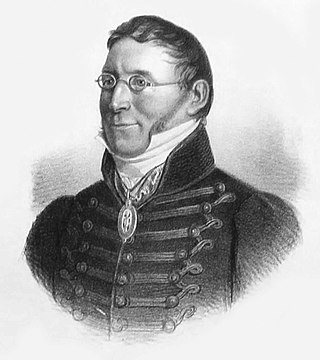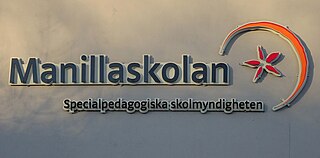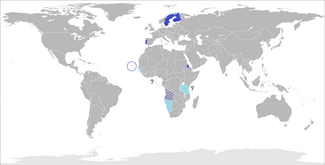
Sign languages are languages that use the visual-manual modality to convey meaning, instead of spoken words. Sign languages are expressed through manual articulation in combination with non-manual markers. Sign languages are full-fledged natural languages with their own grammar and lexicon. Sign languages are not universal and are usually not mutually intelligible, although there are also similarities among different sign languages.

The Community of Portuguese Language Countries, also known as the Lusophone Community, is an international organization and political association of Lusophone nations across five continents, where Portuguese is an official language. The CPLP operates as a privileged, multilateral forum for the mutual cooperation of the governments, economies, non-governmental organizations, and peoples of the Lusofonia. The CPLP consists of 9 member states and 33 associate observers, located in Europe, South America, Asia, Africa and Oceania, totaling 38 countries and 4 organizations.

Portuguese creoles are creole languages which have Portuguese as their substantial lexifier. The most widely-spoken creoles influenced by Portuguese are Cape Verdean Creole, Guinea-Bissau Creole and Papiamento.

British, Australian and New Zealand Sign Language (BANZSL) is the language of which British Sign Language (BSL), Auslan and New Zealand Sign Language (NZSL) may be considered dialects. These three languages may be considered dialects of a single language (BANZSL) due to their use of the same grammar and manual alphabet and the high degree of lexical overlap. The term BANZSL was coined by Trevor Johnston and Adam Schembri.

Portuguese is spoken in a number of African countries and is the official language in six African countries: Angola, Mozambique, Guinea-Bissau, Cape Verde, São Tomé and Príncipe and Equatorial Guinea. There are Portuguese-speaking communities in most countries of Southern Africa, a mixture of Portuguese settlers and Angolans and Mozambicans who left their countries during the civil wars. A rough estimate has it that there are about 14 million people who use Portuguese as their sole mother tongue across Africa, but depending on the criteria applied, the number might be considerably higher, since many Africans speak Portuguese as a second language, in countries like Angola and Mozambique, where Portuguese is an official language, but also in countries like South Africa and Senegal, thanks to migrants coming from Portuguese-speaking countries. Some statistics claim that there are over 60 million Portuguese speakers in the continent.

The Portuguese-speaking African countries, also known as Lusophone Africa, consist of six African countries in which the Portuguese language is an official language: Angola, Cape Verde, Guinea-Bissau, Mozambique, São Tomé and Príncipe and, since 2011, Equatorial Guinea. The six countries are former colonies of the Portuguese Empire. From 1778 until independence, Equatorial Guinea was also a colony of the Spanish Empire.
Brazilian Sign Language is the sign language used by deaf communities of Brazil. It is commonly known in short as Libras.
Portuguese Sign language is a sign language used mainly by deaf people in Portugal.

Guinean Portuguese is the variety of Portuguese spoken in Guinea-Bissau, where it is the official language.

Swedish Sign Language is the sign language used in Sweden. It is recognized by the Swedish government as the country's official sign language, and hearing parents of deaf individuals are entitled to access state-sponsored classes that facilitate their learning of SSL. Swedish sign language is strongly linked to the culture of Sweden. There are around 13.000 native speakers and a total of 30.000 speakers.

Pär Aron Borg was a Swedish educator and a pioneer in the education for the blind and deaf.

The official language of Guinea-Bissau is Portuguese, which was spoken by 32.1% of the population according to the 2009 census. It is the language of instruction in schools, the language of literary production, the written press, legislation and administration.
Guinea-Bissau Sign Language is an incipient sign language evolving from the single school for the deaf in Guinea-Bissau, which was founded in Bissau in 2003. In 2005 a linguist and Portuguese Sign Language teacher found GBSL to still be basic, but with some consistency among students in the school and village use when the students went home.
Eritrean Sign Language (EriSL) is a sign language widely used in Eritrea by the 15000 deaf individuals who live there. It developed out of the Swedish and Finnish Sign Languages, that were introduced by Swedish and Finnish Christian missionaries in 1955, containing a certain amount of local Eritrean signs and having ASL-based Sudanese influences. According to Moges 2011, 70% of the EriSL and Finnish signs are identical. Since 2005, the Eritrean National Association of the Deaf has made linguistic purification attempts to replace Swedish and Finnish signs from the EriSL lexicon by 'Eritrean' ones in an effort to create a more distinct, "indigenous" language. This process is referred to as 'demissionization'.
Manuel Ferreira was a Portuguese writer that became known for his work centered around African culture and literature.
Deafness in Portugal involves several elements such as the history, education, community, and medical treatment that must be understood to grasp the experiences of deaf and hard-of-hearing (DHH) individuals in this region. Currently there are 60,000 people in Portugal that are deaf sign language users. Among that number are 100 working sign language interpreters. Currently, the form of sign language used in Portugal is Portuguese Sign Language. In Portugal, the cities Lisbon and Porto have the largest deaf populations.

Manillaskolan, before 1879 Allmänna institutet för döva och blinda å Manilla, is a Swedish state school for blind, deaf and hard of hearing children, founded by Pär Aron Borg in 1809. Until the autumn term 2013, the school was located at Djurgårdsvägen on Södra Djurgården in Stockholm. The school is now located in the former premises of the Stockholm Institute of Education in Konradsberg on Kungsholmen.

Ossian Edmund Borg was a Swedish teacher of the deaf and head of the Manillaskolan school for the deaf. He was the son of Pär Aron Borg, pioneer of deaf schooling in Sweden.
Cape Verdian Sign Language is the sign language used by the deaf community in Cape Verde, numbering around 1500–4000. It is descended from Portuguese sign language and is mutually intelligible with it at the present, although it contains some local adaptations. Cape Verdian sign has not been under any university research. However, a Cape Verdian Sign dictionary was released in 2019.















